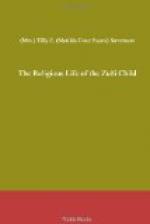The first of the [=A]h-shi-wi, or Zuni, to cross this river were the Aen-shi-i-que, or Bear gens; T[=o]-w[=a]-que, Corn gens; and [t]Ko-[=o]h-l[=o]k-t[=a]-que, Sand Hill Crane gens. When in the middle of the river the children of these gentes were transformed into tortoises, frogs, snakes, ducks, and dragonflies. The children thus transformed, while tightly clinging to their mother’s necks, began to bite and pinch. The mothers, trembling with fear, let them fall into the river. [=A]h-ai-[=u]-ta and M[=a]-[=a]-s[=e]-we, missing the children, inquired, “Where are the little ones?” The mothers replied, “We were afraid and dropped them into the water.” The war gods then cried out to the remainder of the people, “Wait, wait until we speak with you,” and they told the women to be brave and cling tightly to the children until they crossed the river. Obeying the gods’ commands, they carried the little ones over, though they were transformed just as the others. Upon reaching the opposite shore, they were again restored to their natural forms, excepting their hands, which were duck-webbed. These webs were cut with [=A]h-ai-[=u]-ta’s stone knife and thus restored to perfect hands.
The mothers whose children fell into the waters were grieved and refused to be comforted. The Priest Doctor was also grieved, and said, “Alas, where have the little ones gone?” [=A]h-ai-[=u]-ta and M[=a]-[=a]-s[=e]-we replied, “We will go and learn something of them,” and upon descending into the lake they found the beautiful kiva, in which the children were assembled; but again they had been changed; they were no longer reptiles, but were of a similar type to the K[=o]-y[=e]-m[=e]-shi and K[=o]-m[=o]-k[)e]t-si, and since that time they have been worshiped as ancestral gods, bearing the name of K[=o]k-k[=o]; but the little war gods knew them, and addressed them as “My children,” and they replied, “Sit down and tell us of our mothers.” When they told them that their mothers refused to be comforted at their loss, they said, “Tell our mothers we are not dead, but live and sing in this beautiful place, which is the home for them when they sleep. They will wake here and be always happy. And we are here to intercede with the Sun, our father, that he may give to our people rain, and the fruits of the earth, and all that is good for them.” The [=A]h-shi-wi then journeyed on, led by [=A]h-ai-[=u]-ta and M[=a]-[=a]-s[=e]-we, to the present site of Zuni. Many, however, lingered at a spring some fifteen miles west of Zuni, and there established the village Tk[=a]p-qu[=e]-n[=a] (Hot Spring).




